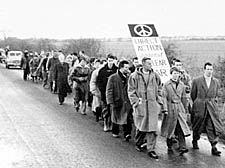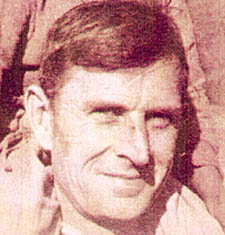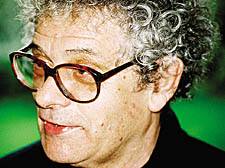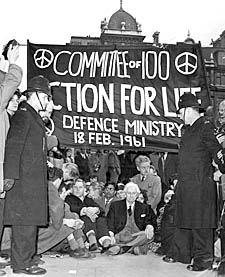
The march to a nuclear missile base being built in Swaffham, Norfolk. In front with Scott are Michael Renale and April Carter, both later jailed for cicil disobediance

Michael Scott

Lewis Chester

Scott and Bertrand Russell protest at the MoD |
The ‘angry Christ’ who fought apartheid
Michael Scott’s passion for equality made him a global firebrand, writes Illtyd Harrington
Troublemaker: Michael Scott and His Struggle for Justice by Ann Yates and Lewis Chester
Aurum, £16.99 order this book
MICHAEL Scott was the church’s most turbulent priest since Thomas Beckett was slaughtered in Canterbury cathedral in 1170. At times he was infuriated and intransigent, but after all an elemental force for good.
Lewis Chester and the late Ann Yates have managed to find what they could behind a man who was remote and private, while paradoxically the most dynamic cleric on three continents. Scott revealed it in a personal letter to his great patron David Astor, the legendary editor of the Observer. It was that he had suffered appalling sexual abuse as a child from the headmaster in a private school.
Scott was born in leafy Sussex, the youngest of three boys. His father, a muscular High Church vicar was posted to the rough Southampton dock parish of Northam, when Michael was four. There he easily formed friendships with the slum children and built an affinity with the poor which lasted all his life, whether in Sophia Town, South Africa, or with the Nagas in north eastern India.
Ordained in 1930, he soon tired of his gentle parishioners of South Kensington and headed for Clapton, east London, which was a deprived stricken part of Docklands. Here he soon saw that the Communist Party was the most effective political force and he formed close alliances with party leaders.
Years later his activities soon had him labelled a party agent, as he had been, working as a courier and fund distributor.
His anger and passion fuelled by what he had seen, drove him closer to the Communist Party, and he acted as a recruiter in the wartime factories of Park Royal.
Communists were eager to join in the war against Hitler and Scott joined the RAF.
They had to invalid him out when he was diagnosed with Chrohns Disease, a chronic and painful intestinal illness.
Undaunted he dropped his communist mentors and took off in 1943 to begin his heroic and historic mission in South Africa.
It is hard now to understand what a primitive use of power was exercised there. Even what was portrayed as the benign regime of Jan Smuts was one where two and half million whites ruthlessly exploited 10 million blacks with every possible humiliation.
People of the calibre of the Reverend Trevor Huddleston trod a cautious non-committal path. Scott, however, rapidly assessed the situation, wildly indifferent to hierarchic control.
Sadly, Afrikaner force was about to assert its iron hand. In what was regarded elsewhere as a liberal time, this solitary priest embarked on his career of passive resistance, spending three months in jail for refusing to pay his £50 income tax.
Like the blacks, Indians were also rated as second-class citizens and they welcomed him when he arrived in Durban in challenging mood to the segregation laws.
After that he went to a black shantytown near Johannesburg. Nicholas Monterat, the novelist and one of the few whites to venture into the squalor described him as “an angry Christ”.
He was an international personality, recognised by the newspapers and magazines and he was accorded a saintly status that was not echoed by his exacerbated superiors.
In 1947, Scott, accompanied by Ruth Thirst, who was later murdered by the South African security service, faced up to the most brutal Afrikaner farmers in Bethel – a territory governed by the Sjambaks and the Bible.
After that, he headed for south-west Africa, where the Hereros tribe was suffering from South African genocide. A people of 80,000 had been reduced to 15,000 and their traditional grazing lands stolen.
This led to him being asked to go to the UN to plead their case. The election in 1948, brought the nationalists to power and the ultimate enforcement of Apartheid.
Scott was a marked man but an irrepressible one. Lewis Chester’s fluid text carries his saga along in compelling style. Gradually the horror of South Africa began to unfold to the whole world. Scott in the meantime grew as an international figure, aided and abetted by the steely determination of David Astor.
With crystal clarity the politics of Scott’s London period are told with its clash of powerful personalities – the Africa Bureau with Scott as director and his rival Canon John Collins’s Christian Action.
A fascinating insight into the background and politics, which spilled over into CND. Scott joined the philospher Bertrand Russell for direct action. Both went to jail.
By 1955, Scott took space in a house in Belsize Park. His love of nude sunbathing alarmed a parishioner when he sat on the roof of Hampstead Parish Church soaking up the sun.
He wrote his autobiography A Time to Speak in 1958. An approving critic wrote of him: “He is a mixture of Jesus, Gandhi and more than a trace of Karl Marx.”
In the last 13 years of his life he had found a good companion. He loved walking in the stillness of Primrose Hill late at night. He died in King Henry Road on the September 14, 1983 of cancer of the liver.
|





